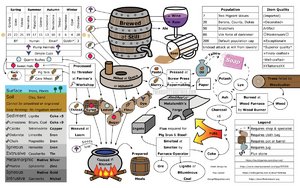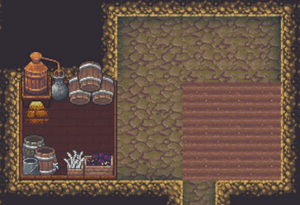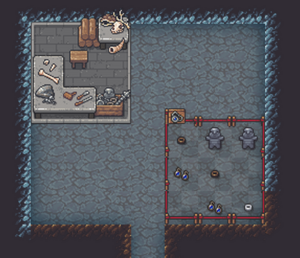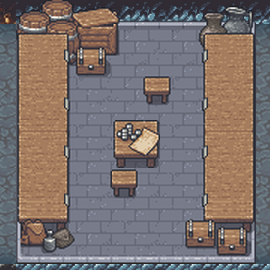- v50 information can now be added to pages in the main namespace. v0.47 information can still be found in the DF2014 namespace. See here for more details on the new versioning policy.
- Use this page to report any issues related to the migration.
Industry
v50.12 · v0.47.05 This article is about the current version of DF.Note that some content may still need to be updated. |
All dwarves love money, and a complete industry in all its glory is the easiest way to make lots and lots of money.
Traditionally, industries have been broken into primary (resource extraction), secondary (the refining and reprocessing of these resources into goods), and tertiary (provision of services). Although dwarves are not typically known for their intellectual pursuits, with the introduction of libraries, your fortress can even have a quaternary sector "industry" (science, information generation and sharing).
Industries can be broken into the following categories. These categories are based on Economy Sectors. Note that the end products of one industry are often the inputs to another, and some industries can fit into more than one category.
Primary industries[edit]
- Wood industry: Growing and cutting wood to produce items, including furniture and fuel. To start wood crafting, a carpenter's workshop is needed. Wood can be used for making pretty much anything, and is the only material that can be used to create beds in particular, but note that wooden weapons will become training weapons instead (and danger rooms are no longer very viable) and that wood is definitely not magma-safe (obvious). Those tree-hugging elves will whine and send a diplomat begging you to stop if you chop too many trees down.
- Stone industry: Exploration and mining of stone to produce buildings and items. Stone is a versatile material and can be used to make many types of furniture, crafts, and other useful objects, or turned into blocks and used as a cheap and abundant material for constructions to protect your squishier dwarves. Sure, constructions of any material are all but indestructible to invaders, but a stone fortress is certainly the dwarfy option.
- Farming industry: The gathering and farming of plants. Early fortresses can get by with whatever grows outdoors, but farming is invaluable for keeping any fortress larger than an outpost fed and boozed up in the long run. Several plants are also important for turning into thread, cloth, and parchment, and an experienced grower can have an incredible effect on secondary industries.
- Fishing industry: Most natural bodies of water contain at least some delicious fish and other aquatic vermin. Fishermen will automatically fish in nearby pools and rivers unless you designate a fishing area, and combined with a fishery can put out a truly impressive amount of raw food and shells for cooking and crafting.
- Meat industry: Animals can be hunted, captured, or bred, and later butchered for a number of goods. The meat from an adult animal provides fortresses with a quick injection of food, and hides can be tanned into leather as an alternative to cloth for many uses (and the only source of backpacks, quivers and waterskins for your military). Experienced craftsdwarves will turn bone, teeth, horns and skulls into bone trinkets to sell, or decorate existing goods with high-quality yet somewhat morbid additions for a value boost.
- Beekeeping industry: On embarks with wild bee colonies, hives can be constructed to nurture bees and collect honeycomb and royal jelly, for creation of several (mostly novelty) foods and drinks.
- Poultry industry: Raising egg-laying animals primarily to collect and consume the eggs. Excess animals can be used in the meat industry as a byproduct. Several animals will lay large clutches of eggs at once, making for very consistent and valuable sources of raw food for cooking. Crundles produce a ton of eggs, and hatch in adult form, making them a great source of eggs, meat, bones and skulls (nasty but effective).
Secondary industries[edit]
- Alcohol industry: The production of alcohol to keep dwarves hydrated and content. Dwarves drink as many times as you blink per day. They are also massive alcoholics, and if you cut their supply of booze they will get very cranky and show withdrawal symptoms. Alcohol is made at the still and can itself be cooked into food. Somehow.
- Armor industry: Metal, wood, leather, and bone are used to produce armor to keep your dwarves safe. Wood, leather, and bone provide minimal protection, but can suffice early on if a military presence is critical. Metal makes for much more effective armor, and well-crafted steel gear can massively increase the lifespan of your dwarves.
- Ceramic industry: Clay is used to create moderate quality containers, bricks, crafts, and statues, offering a slightly more complex but slightly more valuable alternative to stone. Kilns are also used to produce gypsum plaster for Healthcare and pearlash for the Glass industry.
- Finished goods industry: Almost all materials can be used to produce crafts for export. Often base of your economy, crafts can be mass produced by any dwarf and improved in several ways. Early on, decently-skilled stone crafters can provide enough profit to get some important early items from caravans; for more mature fortresses, crafts made of valuable metals like gold and silver improved with rare gems or valuable bones can be immensely profitable.
- Food industry: Cooking of items such as meat, eggs, flour, and plants to make meals for hungry dwarves. Although dwarves can eat many food items raw, cooking is required to make a number of edible materials palatable for your dwarves, and skilled cooks can make meals that are both luxurious to eat and bafflingly profitable.
- Fuel industry: The production of fuel to support the metal, glass and ceramics industries, either with charcoal or coal. Wood can be turned into charcoal, but the processing of bituminous coal or lignite can quickly become necessary for fortresses unable to secure safe magma.
- Furniture industry: Using stone, wood, and metal to produce furniture, primarily for installation in your outpost. Beds are a must to keep dwarves happy, and everyone likes to have their own cabinet and chest. Doors are invaluable for security, many nobles demand proper furniture arrangements, and all of the above can be improved by craftsdwarves to make lavish statue gardens or generally impressive fortress layouts.
- Glass industry: Sand is used to create several types of glass. Green glass is low value, but can be mass-produced with nothing but fuel and a sand deposit, allowing for a cheap source of furniture, trap components, and gems to train jewelers. With secondary materials, more valuable clear or crystal glass can also be created.
- Gem industry: Raw gems are cut, some into finished goods, while most are then used to decorate ("encrust") a multitude of items. With a bit of practice, jewelers can greatly improve the quality of goods and furniture with high-value, masterfully-cut gemstones, or add lower-value gems to crafts for trading.
- Metal industry: Raw ore is refined into metal bars, which may be used for weapons, armor, furniture, and crafts. Prioritize your weapon-grade metals (bronze, steel, iron, etc...) to make weapons and tools. Gold, aluminum and platinum are useful if you want to bump up the value of certain rooms or satisfy your roleplaying needs (gold throne, gold chains that hold the most exotic pets, gold doors leading to your monarch's room, etc...), while several alloys exist for the aesthetic-minded dwarf.
- Soap industry: The production of soap to be used in healthcare. A few bars of soap can save your dwarves from infection, and even the hairiest of cavern-dwellers enjoy being clean sometimes.
- Textile industry: Plant fiber, spider silk, and wool/hair thread are woven into cloth to produce clothing, rope, bags, and bandages, and to decorate crafts. Clothing worn by dwarves will degrade over time and result in unhappiness, so being able to produce replacements can be important after the first year or two of a fortress' lifespan, especially when sewn into high-quality garments by experienced clothiers.
- Extract industry: Vermin and plants can be processed into valuable extracts for export. Most extracts have no real use beyond selling, but they can provide a bit of money in a pinch.
- Weapon industry: Metal, wood, stone, and bone are used to produce weapons to keep the goblins away. The difference between a quickly-made copper sword and a masterfully-forged steel warhammer cannot be overstated when it comes to dangerous foes.
- Paper industry: Papyrus, cloth plants, or animal hide with milk of lime are processed into paper sheets. These are used for quires and scrolls. Written-on quires and parchments can be bound into a book, allowing your scholars to slowly build up a wonderful library of imported and copied books or hand-written intellectual diatribes.
Tertiary industries[edit]
- Administration: Dwarves who process work orders, keep the inventory, administer justice, and meet with foreign diplomats. Also good at pulling levers and encountering truly unforeseeable career-altering incidents.
- Healthcare: Patching up your inevitably-wounded dwarves. With the power of thread, splints, crutches, cloth, soap, and a little dwarven ingenuity, citizens and military dwarves can be saved from injuries that would otherwise cripple them for life (or at the very least, patched up enough to keep hauling your garbage around the fortress).
- Military: Brave dwarves put themselves in danger so that others may live in peace. Some fortresses can get away with a small handful of troops and plenty of traps; others will need the full might of the dwarven military-industrial complex to keep the citizens safe from invaders, underground horrors, living nightmares, hostile wildlife or much worse.
- Trading: Fortress goods are exchanged for materials and goods from other civilized places. While a fully-fledged fortress can become self-sufficient, turning random junk into a quick supply of raw materials can be very valuable early on, and even the elves are known to bring some interesting wares every so often.
- Entertainment: Attract visitors to your fort using Taverns. Everyone loves a good clown.
Quaternary industries[edit]
- Library: Dwarves and visiting scholars will discuss new ideas about life, the universe and everything else. Quires and scrolls can be filled with the acquired knowledge and can be read by your dwarves for happy thoughts (or be copied and sold for profit).
- Temple: Dwarves are surprisingly religious people, and a good temple can give them the peace of mind of being able to pray to their deities of choice. Many established religions will seek temples specifically to their chosen pantheons.
Primary Secondary Tertiary Quaternary



